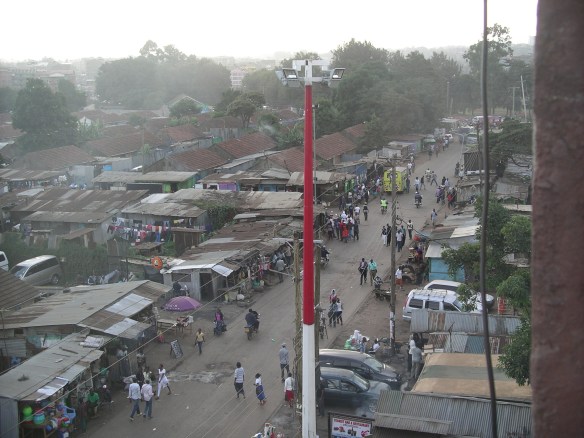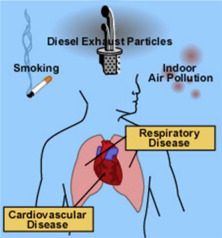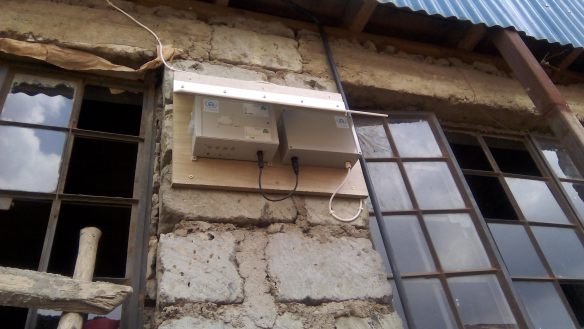by Priyanka de Souza
In 2014, the World Health Organization released a report stating that in 2012, exposure to air pollution was responsible for an estimated 7 million premature deaths. (3.7 million deaths due to outdoor air pollution, and 3.3 deaths due to indoor air pollution). This finding confirmed the fact that air quality is the world’s single largest environmental health risk. Addressing the issue of exposure to air pollution thus has the potential to save millions of lives. So- how do we go about this?
Many countries have recognized the importance of improving air quality and have put in place measures to reduce air pollution. These measures include instituting national air quality standards (South Africa has even defined the right to an environment that is not detrimental to health or well-being to be a constitutional right). However, despite the setting of standards, and the putting in place of policies, the prohibitive cost of reference air quality monitoring systems ($150,000 -$200,000) has prevented some countries from measuring air quality to ensure compliance with these standards. Further, even when monitors are put in place, they are usually located in relatively clean areas.

Currently Air Quality Monitoring is Missing in Many Cities Like Nairobi
Low cost sensors (costing a few $ to a few $1000) have the potential to help us move from a paradigm of high cost, highly accurate, sparsely located reference air quality monitors, to a dense, low cost, reasonably accurate air quality monitoring paradigm. However, when such sensors are brought up in meetings- especially those in which public officials are present, they are usually decried. Opponents say that there are currently no standards or certification criteria defined for such sensors. Further- the flood of low cost sensors in the market, make it very hard to determine the reliability of each model.
This is indeed a problem. In fact the deluge of data from uncertified sensors such as these, have been used to cast aspersions on initiatives such as the ‘odd-even’ Delhi car scheme, as data from some of these devices actually showed a rise in air pollution despite the reduction of cars on the road. Complicating the challenge of certification, cheap sensors from the same manufacturer often have different characteristics. The US Environmental Protection Agency has released a report that looks at some of the low cost sensors on the market. The EPA, however, has calibrated these sensors in the clean environment in North Carolina, and not much is known about how these sensors will perform in polluted, hot, humid environments in the developing world. Temperature and humidity affects the stability of such sensors dramatically. More work is definitely needed to quantify the accuracy of such sensors in different conditions.
Given this limitation, do low-cost sensors have a place in today’s world? I would argue that they are extremely important. This is because of three reasons: One- Low cost sensors can be used to further citizen science by providing citizens with tools to measure real-time air quality in their homes and work places. Thus, these sensors can be used as important awareness raising and advocacy tools. The European Environmental Bureau, for example, recruited influential members of the EU Parliament in Brussels to carry these sensors around with them for a day and report the data. The high particulate matter counts were widely reported on and galvanized action.
Two- by comparing data generated by different nodes in a dense, low-cost sensor network, pollution hot-spots and sources of pollution can be identified. This allows the development of pollution management plans. It allows us to move beyond compliance and litigation into a conversation about so what can we do/what should we do? This is important as the debate in most countries has moved beyond ‘Is air quality an issue’ to: ‘What do we need to do, and how much?’
If we had such devices at work-places, next to construction sites, near power plants, close to mines, management plans, emergency action plans could be developed in case pollution levels rose to levels that could have a serious impact on health. As air quality is an issue that impacts everyone: rich and poor, it has a lot of traction and can be a powerful tool to obtain changes in policy. These devices can thus be used to identify air quality baselines and to track the impact on air quality of various measures implemented by the government such as the promotion of non-motorized transport, the setting of fuel standards. The improvement of air quality can be a powerful catalyst for action.
Three- Air pollution is not the problem. Exposure to air pollution is. Maps of air quality generated from such networks can be overlaid on population density maps, and exposure maps can be created. Mobile low cost sensors can be used for integrated monitoring (both indoor and outdoor) air pollution to track the real air qualities that people are exposed to as they move about their daily life. Stationary air quality reference monitors cannot do this. Such an integrated approach can truly allow for the measurement of quality of air that is actually breathed in by people as they go about their daily lives, and can thus be used to pinpoint health effects.
The use of these sensors in measuring indoor air pollution is an important point, because indoor air pollution is responsible for roughly half of the total premature deaths estimated to be caused by air pollution. In addition, household air pollution is a major source of ambient air pollution, but the measurement of the same is focused on far less. A study in India conclusively links the health of babies with the quality of air breathed in by mothers during pregnancy (sensors were attached to the expectant mothers during their pregnancy).

Outdoor and Indoor Pollution are linked to adverse health impacts
Another innovative and promising air quality monitoring technique involves estimating pollution via satellite imagerSatellite data can be used to estimate aerosol optical depths (AOD) over the entire globe. Particulate matter concentrations can be inferred from the AOD. In theory the resolution of such measurements can be done in areas of a few square kilometers, however, at such resolutions the error margins can be quite high. A limitation of such an approach is that such data is only collected once a day when the satellite orbits above a location. It is believed that the use of geostationary satellites will allow data to be collected whenever sunlight is present, and the location is not obscured by cloud cover, but this is yet to be seen. Data from satellites, however, can be used to identify districts in which air pollution is high and thus inform the placement of low cost sensors. Data from these low cost sensors can also be fed back into satellite driven models that can thus improve the model, and enable the generation of forecasts.
Thus low cost air quality monitoring solutions offer the developing world a wonderful opportunity to leap-frog the stationary, expensive air quality monitoring stations of the developed world, and help inform the making of policies to reduce air pollution. In 2014, Resolution 7 was passed at the UN Environment Assembly which set UNEP a mandate to help countries tackle air quality. UNEP noted that the first step in doing so was collecting data on air quality. It thus developed a DIY air quality monitoring unit costing ~ USD 1500. The unit makes use of low cost sensors manufactured by Alphasense to measures harmful gas (NOx, SOx, VOCs, CO, O3) concentrations as well as particulate matter count.
It made the blue prints public (The circuit diagrams +code can be found here) so that governments/citizens could assemble, use the unit and even modify it, as they see fit. The unit attracted a lot of attention in the press. Several countries contacted UNEP asking for help to deploy a network of such units. If the units are networked (i.e. calibrated against each other), and are deployed in a wide array of sites, then using machine learning, it is possible to filter out ‘noise’ in the data produced by the network resulting from interfering gases, changes in temperature and humidity. This would thus increase the accuracy of the whole network. Further research needs to be carried out on how many units need to be deployed to gain an ‘acceptable’ accuracy.
We at UNEP thus wanted to deploy a pilot network of air quality monitors to better understand what the process would entail so that we could share our experience with interested citizens and governments. Thus we decided to deploy a six node air quality monitoring network in the city of Nairobi which faces many air quality problems. As we wanted the network to be ready soon, we did not use the UNEP air quality monitors for the network, as the unit is not currently being commercially produced. Instead, we used boxes we bought from the company: Atmospheric Sense. These boxes were the ones deployed by Professor Rod Jones from the University of Cambridge in a Heathrow airport air quality monitoring network study, and employ the same sensors as the UNEP unit.
Deploying Low Cost Air Quality Monitors in Nairobi
The first step in deploying the network was identifying suitable sites for the units. Here the the wonderful NASA GLOBE program helped. NASA has developed a list of protocols for the conducting of measurements of various parameters of the atmosphere, biosphere, hydrosphere and lithosphere. The GLOBE program trains teachers from all over the world in these protocols. These teachers then train their students to conduct measurements. NASA then uses the data from these measurements to validate and calibrate satellites.
I found that the Kenyan GLOBE program is very active. Several GLOBE schools in Kenya had weather stations which the kids work with. I therefore thought that it would be very interesting to co-locate our air quality monitors with the GLOBE weather stations in these schools. In this way, we could get wind speed and wind direction data along with air quality data, AND teach the children in these schools about air quality and about how to use the monitors.
After seeking permission we had to choose optimal sites for the monitors. The units we deploy were designed to be powered from the mains power supply. They had batteries that could last for 3 days. We thus had to ensure that our units were sited close to power sources. We wanted to measure air quality at the height at which people breathe. However, we did not want them to be in reach of anyone who could tamper with the units. We therefore deployed all units at the height of 2-3 m above the ground. We had wanted the units to be pole mounted so that they could have access to pollution from 360 degrees. However, the units were designed to be wall mounted and therefore we had to identify walls on which the units could be mounted so that they would face the general wind direction. Finally, the Atmospheric Boxes do not function well in rain or high temperatures. Although the units came with their own sun shades, we had to make sure that the units would be adequately protected from the elements in order to minimize exposure to the elements.
We finally found sites to deploy the air quality monitors in UNEP: Alliance Girls School, St Scholastica, All Saints Cathedral School, the Kibera Girls Soccer Academy and the Lunga Lunga community center. Alliance Girls School in Kikuyu was our urban background site. St Scholastica is a stone throw’s away from Thika Highway- a road notorious for traffic jams in Nairobi. All Saint’s Cathedral School is close to Mbagathi road and several small shops and industries. Kibera Girls Soccer Academy is situated right near a garbage dump site that we thought would be useful to monitor.
Further, on Saturdays, I teach kids at the school how to use the simple computers called Raspberry Pis, and thought it would be a very wonderful thing to show the children how to play with the air quality data on the Pi. For our last site, we had originally chosen Moi Forces Academy in Eastleigh. However, we later decided that we would learn nothing more by installing a monitor in this location as the schools is situated far away from the main road. We therefore decided to look for a site in the industrial area to get a true picture of air quality in Nairobi.

Low Cost Air Quality Monitor on a School
I was in touch with the community center in the Lunga Lunga slum about installing a Raspberry Pi there. We asked them if we could also install the air quality monitor and they agreed. The Lunga Lunga site is situated close to a factory that manufactures chemicals for the production of tear gas, a factory that produces electrical components, Oshwal Chemicals industry, and an open garbage burning pit. It is also close to to Lunga Lunga main road.
Atmospheric Sense shipped the units to us. We finished the deployment of the units in the first week of May. The data is streaming from these units to Alphasense servers. The first 3 weeks worth of data was presented at the Science Policy Forum of UNEA by Professor Roderic Jones of the University of Cambridge. Even with 3 weeks of data, by plotting the filtered measurements against wind speed and wind direction, potential sources were identified.We are currently working on automating the data collection, post processing and then visualization in order to make the data available on UNEP’s website UNEP Live so that the results are understandable to people. Please do check the website or email me for updates about this.
The last step of the process involves holding workshops in each school to educate the children about the unit and the importance of air quality. We will be doing this in the next few months. We learnt a lot from deploying the network. We learnt that the cost of the units is a small fraction of the total cost of network deployment. This is because maintenance of the network, as well as the analysis of the data is time consuming and expensive. However, given the valuable insights we obtained from the data, we believe that such low cost networks are important tools for governments to use to collect air quality data in the future.

Pingback: Smart Air Quality Monitoring for Nairobi | kenyacharcoal